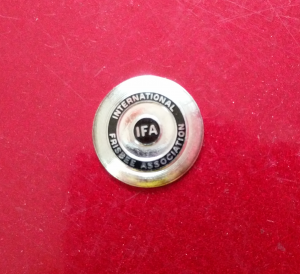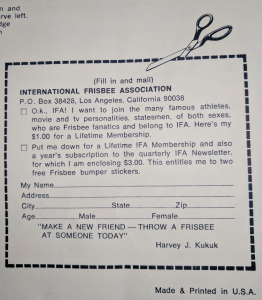 The International Frisbee Association (IFA) Newsletter made its debut in 1968 and brought together previously isolated and undocumented pockets of disc play. Stories of Frisbee activities, including stories about people who could throw a Frisbee in different ways and could make fancy trick catches began to circulate. There were stories of the legendary Spyder Wills from Laguna Beach, whose floating throws and fancy catches were unlike what anyone else could do with a Frisbee. The Frisbee community found out about the big International Frisbee Tournament (IFT) in the Upper Peninsula of Michigan, Ken Westerfield and Jim Kenner’s Canadian Open Frisbee Championships in Toronto, Dan Roddick’s Pennsylvania State Championship events, and Wham-O’s National Junior Championships.
The International Frisbee Association (IFA) Newsletter made its debut in 1968 and brought together previously isolated and undocumented pockets of disc play. Stories of Frisbee activities, including stories about people who could throw a Frisbee in different ways and could make fancy trick catches began to circulate. There were stories of the legendary Spyder Wills from Laguna Beach, whose floating throws and fancy catches were unlike what anyone else could do with a Frisbee. The Frisbee community found out about the big International Frisbee Tournament (IFT) in the Upper Peninsula of Michigan, Ken Westerfield and Jim Kenner’s Canadian Open Frisbee Championships in Toronto, Dan Roddick’s Pennsylvania State Championship events, and Wham-O’s National Junior Championships.
The November 1969 “All Comers” meet in Berkeley, California, advertised a “Style throwing and catching” activity area and also a “Free exercise” activity area in addition to the other more traditional Frisbee events like guts, distance, and accuracy.
By the early 70’s, Victor Malafronte and John Weyand of the Berkeley Frisbee Group (BFG) had raised Frisbee tossing and catching to a delicate art form of flowing throws and receptions. Their contemporary counterparts on the East Coast in Toronto, Ken Westerfield and Jim Kenner, were doing the same thing with fast flowing routines, and were already touring as Frisbee Professionals performing in cities across Canada. Vaughn Frick, John Sappington, and Scott Dickson were doing creative trick throws and fancy Frisbee catching on the campus of the University of Michigan during that same period of time. Dan Roddick had featured “Eastern Trick Catch” at his Pennsylvania and New York State Frisbee Championships.
 The IFA Newsletter was instrumental in bringing all three of these groups together in one way or another. It led Victor Malafronte to the 1973 Canadian Open where he met Ken Westerfield and Jim Kenner. In response to meeting Victor, Ken trekked out to the West Coast later that year to meet and play Frisbee with the BFG players. They exchanged volumes of information about Frisbee styles, techniques, and activities. The IFA and its newsletter helped the UM guys get in contact with the Humblies Guts team and to get involved with the IFT, where they met even more Frisbee players like John Connelly, Alan Blake, and Tom Cleworth of the Highland Avenue Aces guts team. The exchange of ideas about creative throwing and catching grew substantially during this 1968-1973 period of time.
The IFA Newsletter was instrumental in bringing all three of these groups together in one way or another. It led Victor Malafronte to the 1973 Canadian Open where he met Ken Westerfield and Jim Kenner. In response to meeting Victor, Ken trekked out to the West Coast later that year to meet and play Frisbee with the BFG players. They exchanged volumes of information about Frisbee styles, techniques, and activities. The IFA and its newsletter helped the UM guys get in contact with the Humblies Guts team and to get involved with the IFT, where they met even more Frisbee players like John Connelly, Alan Blake, and Tom Cleworth of the Highland Avenue Aces guts team. The exchange of ideas about creative throwing and catching grew substantially during this 1968-1973 period of time.
In 1973, Dan “Stork” Roddick met Spyder Wills at Laguna Beach for some Frisbee play and was highly influenced by the graceful and beautiful style that Spyder demonstrated.
All this exchange of Frisbee karma helped to influence the nature of freestyle as it evolved from this point on.
Thanks to the Freestyle Players Association (FPA) for sharing this information with FrisbeeGuru.com.
The entire document is stored on FreestyleDisc.org, as is the FPA’s Hall of Fame.



As a rookie to freestyle, I am LOVING the opportunity to start understanding this history. If I were in my teens or 20s I might not care so much (I never liked history in school). But now that I’m an old geezer in my 50s and I understand how important history is, I am cherishing these posts!
As always, THANKS for all you do Jake! I know it’s a lot of work!
Best,
Paul M Kruse
Pingback: History - Prior to 1948; The pre-plastic flying disc era - FrisbeeGuru
Pingback: History: 1974; The Origin of Freestyle Competition - FrisbeeGuru
Pingback: History: Appendix 1: The Development of Freestyle in Canada - FrisbeeGuru